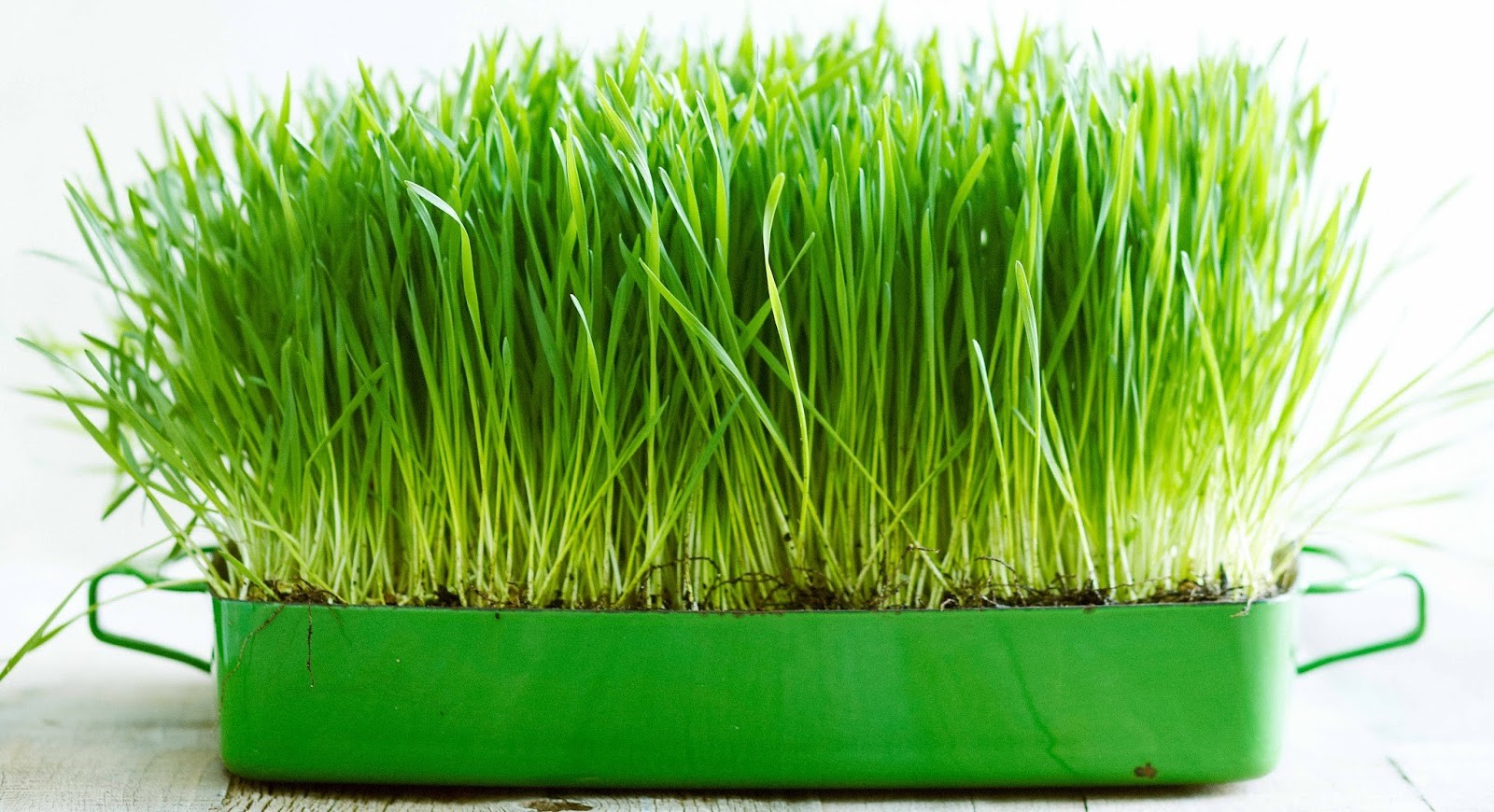What is wheatgrass?
Wheatgrass is prepared from the freshly sprouted leaves of the common wheat plant, Triticum aestivum. It can be grown and prepared at home or purchased in juice, powder, or supplement form. Some claim it can do everything from detoxifying the liver to improving immune function. However, many of its purported benefits have not yet been proven or studied. Here are some of the evidence-based benefits of drinking wheatgrass:
- High in Nutrients and Antioxidants: It is an excellent source of many different vitamins and minerals. It is especially high in vitamins A, C, and E, as well as iron, magnesium, calcium, and amino acids. Of its 17 amino acids, eight are considered essential, meaning your body cannot produce them and you must obtain them from food sources. Like all green plants, wheatgrass also consists of chlorophyll, a type of green plant pigment associated with many health benefits. It also contains several important antioxidants, including glutathione and vitamins C and E. Antioxidants, are compounds that fight free radicals to prevent cell damage and reduce oxidative stress. Some studies have found that antioxidants may help protect against certain conditions, such as heart disease, cancer, arthritis, and neurodegenerative diseases.
- May Reduce Cholesterol: Several animal studies have found that wheatgrass may help lower cholesterol levels. In one study, rats with high cholesterol were given wheatgrass juice. They experienced decreased levels of total cholesterol, “bad” LDL cholesterol, and triglycerides. Interestingly, the effects of wheatgrass were similar to those of atorvastatin, a prescription drug commonly used to treat high blood cholesterol.
- Can Eliminate Toxins: The nutrients in wheatgrass aid your body in getting rid of impurities and stored toxins. For example, chlorophyll aids in the removal of toxic substances and helps support healthy liver function. Once your body is cleansed, you may see an increase in energy levels and better health overall.
- Can Help with Digestion: Wheatgrass has high levels of enzymes that aid in digestion by helping your body to break down food and absorb nutrients. This can help with digestion. The detox effects of wheatgrass clean your intestines. This helps you experience less gas, bloating, and abdominal discomfort. Wheatgrass may also help relieve constipation, irritable bowel syndrome, and other digestive issues.
- Can Boost Your Metabolism: Drinking wheatgrass can boost your metabolism and aid in weight loss. It’s a good choice if you’re watching your weight because it’s low in calories and has no fat. Wheatgrass is a nutrient-dense food leading many people to feel fuller faster and stay full for longer. This can help reduce your desire for foods that are high in sugar or fat.

wheatgrass Superfood
Wheatgrass superfood.
Wheatgrass is often considered a superfood because it contains a high concentration of nutrients and antioxidants that may have various health benefits. However, the term superfood is not a scientific or regulated term, and it does not mean that wheatgrass can cure or prevent any diseases.
Wheatgrass is simply a type of grass that can be consumed as a juice, powder, or supplement. It may offer some advantages over other foods, but it is not a magic bullet for health. It is important to consume wheatgrass as part of a balanced and varied diet that includes other fruits, vegetables, grains, proteins, and healthy fats.
Some other superfoods you need to know.
Some other superfoods that may have various health benefits are:
- Soy: Soybeans have a high concentration of isoflavones, a type of phytochemical that may help lower cholesterol, prevent cancer, and protect against osteoporosis. Soy products include tofu, tempeh, edamame, soy milk, and soy nuts.
- Tea: Many foods considered to be “superfoods” are rich in color, often indicating that they are rich in antioxidants. Tea is no exception. Green tea, black tea, white tea, and oolong tea all contain polyphenols, a type of antioxidant that may protect against cancer, heart disease, diabetes, and neurodegenerative disorders. Tea also contains caffeine and theanine, which may improve alertness and mood.
- Leafy greens: Dark, leafy greens such as spinach, kale, collard greens, and Swiss chard are excellent sources of vitamins A, C, K, and folate. They also contain minerals such as iron, calcium, and magnesium. Leafy greens are rich in fiber and phytochemicals that may help prevent inflammation, oxidative stress, and cancer.
- Salmon: Salmon is one of the best sources of omega-3 fatty acids, which are essential for brain and heart health. Omega-3s may also help reduce inflammation, lower blood pressure, and improve mood. Salmon also contains high-quality protein and vitamin D.
- Dark chocolate: Dark chocolate with at least 70% cocoa content is a delicious treat that may also have some health benefits. Cocoa contains flavonoids that may lower blood pressure, improve blood flow, and protect against oxidative damage. Dark chocolate may also improve cognitive function and mood.
- Wine and grapes: Red wine and grapes contain resveratrol, a compound that may have anti-aging, anti-inflammatory, and anti-cancer effects. Resveratrol may also help lower cholesterol and blood sugar levels. However, moderation is key when it comes to alcohol consumption, as excessive drinking can have negative effects on health.
Other superfoods that are gaining popularity include spirulina, blue-green algae, garlic, wheatgrass, beets and beet juice, turmeric, Brazil nuts, barley, and more. However, it is important to remember that no single food can provide all the nutrients and health benefits that we need. A balanced and varied diet that includes a variety of fruits, vegetables, grains, proteins, and healthy fats is the best way to ensure optimal health.
Wheatgrass juice recipes and its effect.
You can mix wheatgrass with other juices or smoothies to enhance the flavor and nutrition of your drink. Wheatgrass pairs well with citrus fruits, such as oranges, lemons, and limes, as they help balance the bitterness of the grass and add vitamin C. You can also use apples, pears, pineapples, or grapes for a sweeter taste. Some vegetables that go well with wheatgrass are cucumber, celery, spinach, kale, and carrots. You can also add ginger, turmeric, mint, or basil for some extra spice and freshness.
Here are some examples of wheatgrass juice recipes that you can try:
- Wheatgrass Orange Juice: This is a simple and refreshing juice that combines wheatgrass with orange juice. You will need 1/4 cup of fresh wheatgrass and 1 cup of fresh orange juice. You can either juice the wheatgrass and the orange separately and then mix them together, or you can blend them in a blender with some water and strain the pulp. Enjoy this juice chilled or over ice.
- Wheatgrass Coconut Lime Juice: This is a tropical and hydrating juice that mixes wheatgrass with coconut water and lime juice. You will need 1/4 cup of fresh wheatgrass, 1 cup of coconut water, and 2 tablespoons of lime juice. You can either juice the wheatgrass and the lime separately and then mix them with the coconut water, or you can blend them in a blender with some ice and strain the pulp. This juice is great for cooling down on a hot day.
- Wheatgrass Green Smoothie: This is a creamy and filling smoothie that blends wheatgrass with banana, spinach, almond milk, and honey. You will need 1/4 cup of fresh wheatgrass, 1 ripe banana, 1 cup of baby spinach, 1 cup of unsweetened almond milk, and 1 tablespoon of honey. You can either juice the wheatgrass separately and then add it to the blender with the rest of the ingredients, or you can blend everything together until smooth. This smoothie is perfect for breakfast or a snack.
There is no definitive answer to how long it takes to see results from drinking wheatgrass juice, as different people may experience different effects depending on their health status, dosage, and frequency of consumption. However, some general guidelines can be followed to estimate the possible benefits of wheatgrass juice over time.
According to a 2011 research review, wheatgrass juice may have an immediate impact on some aspects of health, such as blood oxygenation, blood alkalinity, and detoxification. These effects may be noticeable within minutes or hours of drinking wheatgrass juice. For example, one study found that wheatgrass juice increased the oxygen levels in the blood of healthy volunteers within 30 minutes of ingestion.
Other benefits of wheatgrass juice may take longer to manifest, as they involve more complex processes such as reducing inflammation, lowering cholesterol, improving blood sugar levels, boosting immunity, and enhancing cognitive function. These effects may require weeks or months of regular consumption of wheatgrass juice to become evident. For instance, one study found that drinking wheatgrass juice for 10 weeks reduced the symptoms of rheumatoid arthritis in patients. Another study found that drinking wheatgrass juice for one month reduced the severity and bleeding of ulcerative colitis in patients.
Tips to optimize the benefits of wheatgrass juice.
The results from drinking wheatgrass juice may vary depending on the individual and the health outcome being measured. However, some general tips to maximise the benefits of wheatgrass juice are:
- Drink it on an empty stomach, preferably in the morning, to maximize its absorption and avoid any interference from other foods or drinks.
- Drink it fresh or as soon as possible after juicing, as the nutrients and enzymes in wheatgrass juice may degrade over time.
- Start with a small amount (such as 1 ounce or 30 ml) and gradually increase the dosage (up to 2 ounces or 60 ml) as your body adjusts to the taste and effects of wheatgrass juice.
- Consult with your doctor before drinking wheatgrass juice if you have any medical conditions or allergies, or if you are pregnant or breastfeeding. Wheatgrass juice may interact with some medications or cause adverse reactions in some people.















